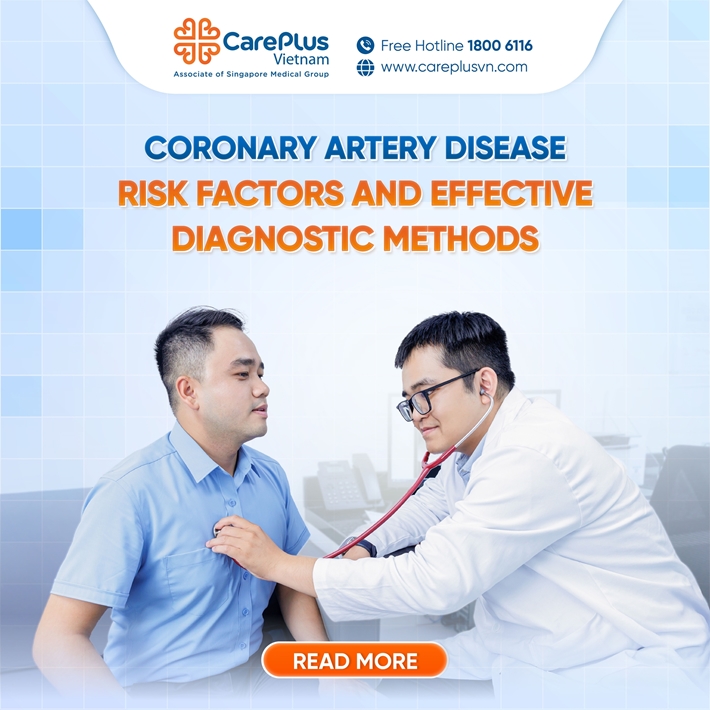CORONARY ARTERY DISEASE – RISK FACTORS AND EFFECTIVE DIAGNOSTIC METHODS

3/18/2025 4:39:30 PM
Before discussing high-risk groups for coronary artery disease (CAD), let’s first understand what CAD is and the role of coronary arteries in the body.
🔹 Coronary artery disease (CAD) occurs when the coronary arteries become narrowed or blocked due to the buildup of atherosclerotic plaques. This reduces blood flow to the heart muscle, causing symptoms such as chest pain (angina), shortness of breath, and, in severe cases, myocardial infarction (heart attack).
The Role of Coronary Arteries in the Body
✅ Supplying Blood to the Heart:
▪️ The coronary arteries are responsible for delivering oxygen-rich blood to the heart muscle. Since the heart continuously pumps blood to the entire body, it requires a constant supply of oxygen and nutrients to function properly.
▪️ If the coronary arteries become blocked, the heart muscle is deprived of oxygen, leading to angina and potentially myocardial infarction.
✅ Structure of the Coronary Arteries:
▪️ The coronary arteries encircle the heart and have two main branches: the right coronary artery (RCA) and the left coronary artery (LMCA).
▪️ The left coronary artery further divides into the left anterior descending artery (LAD) and the left circumflex artery (LCx).
▪️ These arteries branch into smaller vessels that supply different regions of the heart muscle.
High-Risk Factors for Coronary Artery Disease
Uncontrollable Risk Factors:
🔹 Age: The risk of CAD increases with age.
🔹 Gender: Men have a higher risk of developing CAD than women. However, the risk in women increases significantly after menopause.
🔹 Family history: Having a family history of early-onset CAD (before 55 years in men and 60 years in women) is a significant risk factor.
Controllable Risk Factors:
🔹 Smoking:
▪️ One of the leading causes of atherosclerosis and CAD.
▪️ Damages the vascular endothelium, increases platelet aggregation, and reduces blood oxygenation.
🔹 Hypertension (High Blood Pressure):
▪️ Increases cardiac workload, damages vascular endothelium, and accelerates atherosclerosis.
🔹 Dyslipidemia (Abnormal Lipid Levels):
▪️ High LDL cholesterol (bad cholesterol) and non-HDL cholesterol promote plaque formation.
▪️ Low HDL cholesterol (good cholesterol) reduces vascular protection.
▪️ Triglyceride levels > 200 mg/dL also increase CAD risk.
🔹 Diabetes Mellitus:
▪️ Causes vascular damage, endothelial dysfunction, increased platelet aggregation, and chronic inflammation, significantly raising CAD risk.
🔹 Overweight and Obesity:
▪️ Increases the likelihood of hypertension, dyslipidemia, and diabetes.
▪️ Places an additional burden on the heart.
🔹 Sedentary Lifestyle: Lack of physical activity is associated with an increased risk of CAD.
🔹 Unhealthy Diet: High intake of saturated fats, trans fats, salt, and sugar raises the risk of CAD.
🔹 Chronic Stress: Prolonged stress elevates catecholamine levels, leading to hypertension and increased CAD risk.
🔹 Excessive Alcohol Consumption: Contributes to hypertension, dyslipidemia, and cardiomyopathy.
🔹 Sleep Disorders: Conditions such as sleep apnea and insomnia are linked to an increased risk of CAD.
How Is Coronary Artery Disease Diagnosed?
Various diagnostic tests can help detect and monitor CAD, including:
🔸 Blood Tests: Assess blood glucose levels, lipid profile, kidney function, high-sensitivity C-reactive protein (CRP-hs), and lipoprotein (a).
🔸 Electrocardiogram (ECG): Detects arrhythmias and ischemic heart disease.
🔸 Echocardiography: Evaluates myocardial contractility and regional wall motion abnormalities.
🔸 Exercise Stress Test: Helps identify CAD by detecting angina symptoms or ECG changes during exertion.
🔸 Coronary Calcium Scoring and Coronary CT Angiography (CCTA):
▪️ Non-invasive imaging techniques used to assess coronary artery calcification and blockages.
▪️ One of the most effective modern methods for evaluating CAD without requiring an invasive procedure.
🔸 Cardiac Catheterization and Coronary Angiography:
▪️ Considered the gold standard for diagnosing CAD and performing coronary revascularization (stent placement or bypass surgery).
▪️ Since it is an invasive procedure, it is only performed when deemed necessary by a cardiologist.